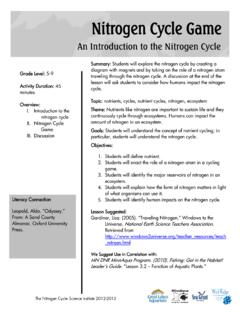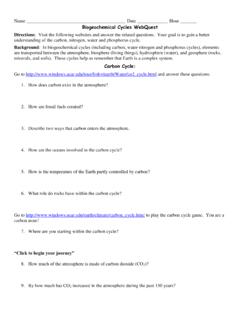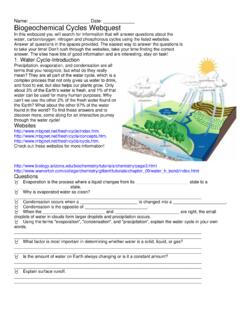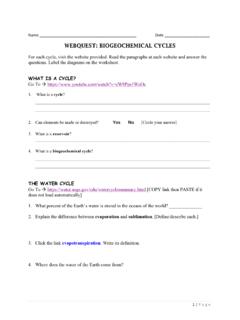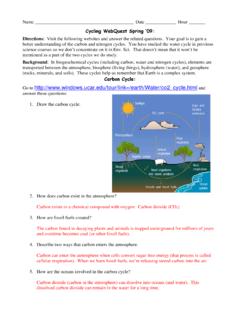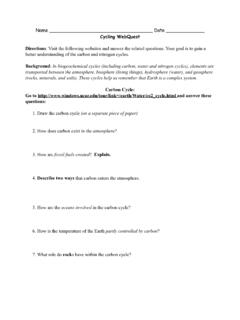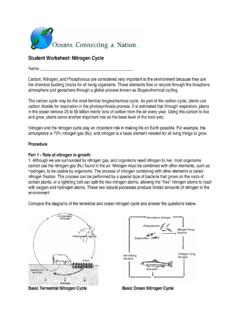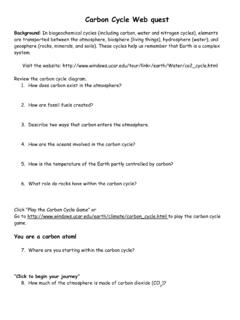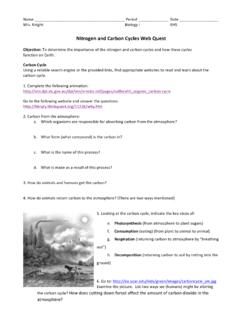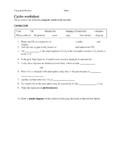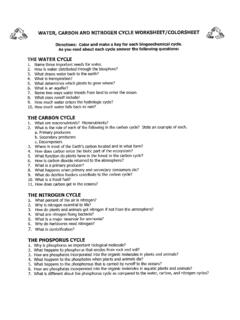Transcription of An Introduction to the Nitrogen Cycle - Great Lakes Aquarium
1 1 The Nitrogen CyThe Nitrogen CyThe Nitrogen CyThe Nitrogen Cyclecleclecle---- Science Institute 2012 Science Institute 2012 Science Institute 2012 Science Institute 2012----2013201320132013 + Grade Level:Grade Level:Grade Level:Grade Level: 5-9 Activity Duration:Activity Duration:Activity Duration:Activity Duration: 45 minutes Overview: Overview: Overview: Overview: I. Introduction to the Nitrogen Cycle II. Nitrogen Cycle Game III. Discussion Summary:Summary:Summary:Summary: Students will explore the Nitrogen Cycle by creating a diagram with magnets and by taking on the role of a Nitrogen atom traveling through the Nitrogen Cycle . A discussion at the end of the lesson will ask students to consider how humans impact the Nitrogen Cycle .
2 Topic: Topic: Topic: Topic: nutrients, cycles, nutrient cycles, Nitrogen , ecosystem Theme:Theme:Theme:Theme: Nutrients like Nitrogen are important to sustain life and they continuously Cycle through ecosystems. Humans can impact the amount of Nitrogen in an ecosystem. Goals:Goals:Goals:Goals: Students will understand the concept of nutrient cycling; in particular, students will understand the Nitrogen Cycle . Objectives: Objectives: Objectives: Objectives: 1. Students will define nutrient. 2. Students will enact the role of a Nitrogen atom in a cycling game. 3. Students will identify the major reservoirs of Nitrogen in an ecosystem. 4. Students will explain how the form of Nitrogen matters in light of what organisms can use it.
3 5. Students will identify human impacts on the Nitrogen Cycle . LessonLessonLessonLesson Suggested:Suggested:Suggested:Suggested: Gardiner, Lisa. (2005). Traveling Nitrogen . Windows to the Universe. National Earth Science Teachers Association. Retrieved from We Suggest Use in Correlation with: We Suggest Use in Correlation with: We Suggest Use in Correlation with: We Suggest Use in Correlation with: MN DNR MinnAqua Program. (2010). Fishing: Get in the Habitat! Leader s Guide. Lesson Function of Aquatic Plants. An Introduction to the Nitrogen Cycle Literacy ConnectionLiteracy ConnectionLiteracy ConnectionLiteracy Connection Leopold, Aldo. Odyssey. From: A Sand County Almanac.
4 Oxford University Press. 2 The Nitrogen CyThe Nitrogen CyThe Nitrogen CyThe Nitrogen Cyclecleclecle---- Science Institute 2012 Science Institute 2012 Science Institute 2012 Science Institute 2012----2013201320132013 Suggested Suggested Suggested Suggested MN Science MN Science MN Science MN Science Standards: Standards: Standards: Standards: The Nature of Science and Engineering The Practice of Science Understand that different models can be used to represent natural phenomena and these models have limitations about what they can explain. Earth and Space Science Human Interaction with Earth Systems Compare the impact of individual decisions on natural systems. Life Science Interdependence Among Living Systems Describe a natural system in Minnesota, such as a wetland, prairie or garden, in terms of the relationships among its living and nonliving parts, as well as inputs and outputs.
5 Life Science Human Interactions with Living Systems Give examples of beneficial and harmful human interaction with natural systems. The Nature of Science and Engineering Interactions Among Science, Technology, Engineering, Mathematics, and Society Describe a system in terms of its subsystems and parts, as well as its inputs, processes, and outputs. Physical Science Matter Recognize that all substances are composed of one or more of approximately one hundred elements and that the periodic table organizes the elements into groups with similar properties. Earth and Space Science Human Interactions with Earth Systems Recognize that land and water use practices can affect natural processes and that natural processes interfere and interact with human systems.
6 The Nature of Science and Engineering Interactions Among Science, Technology, Engineering, Mathematics, and Society Describe a system, including specifications of boundaries and other subsystems, relationships to other systems, and identification of inputs and expects outputs. The Nature of Science and Engineering Interactions Among Science, Technology, Engineering, Mathematics, and Society Identify properties of a system that are different from those of its parts but appear because of the interaction of those parts. 3 The Nitrogen CyThe Nitrogen CyThe Nitrogen CyThe Nitrogen Cyclecleclecle---- Science Institute 2012 Science Institute 2012 Science Institute 2012 Science Institute 2012----2013201320132013 Environmental Literacy Scope and SequenceEnvironmental Literacy Scope and SequenceEnvironmental Literacy Scope and SequenceEnvironmental Literacy Scope and Sequence Benchmarks: Social and natural systems are made of parts.
7 (K-2) In social systems that consist of many parts, the parts usually influence each one another. (3-5) Social and natural systems may not function as well if parts are missing, damaged, mismatched, or misconnected. (3-5) The output from a social or natural system can become the input to other parts of social and natural systems. (6-8) Social and natural systems are connected to each other and to other larger and smaller systems. (6-8) Interaction between social and natural systems is defined by their boundaries, relation to other systems, and expected inputs and outputs. (9-adult) Concepts addressed in this lesson: abiotic factors, cause and effect, cycles, patterns, waste For the full Environmental Literacy Scope and Sequence, see: Great LGreat LGreat LGreat Lakes Literacy Principles akes Literacy Principles akes Literacy Principles akes Literacy Principles Please note, not all Great Lakes Literacy Principles are addressed in this lesson.
8 Water makes the Earth habitable; fresh water sustains life on land. The Great Lakes support a diversity of life and ecosystems. The Great Lakes and humans in their watersheds are inextricably interconnected. Much remains to be learned about the Great Lakes . For more information about the Great Lakes Literacy Principles, visit: 4 The Nitrogen CyThe Nitrogen CyThe Nitrogen CyThe Nitrogen Cyclecleclecle---- Science Institute 2012 Science Institute 2012 Science Institute 2012 Science Institute 2012----2013201320132013 Materials: Materials: Materials: Materials: Introduction to nutrients: Magnetic boards like a dry erase board or a magnetic chalk board (not included in kit) Magnetic pieces of the Nitrogen Cycle Magnetic arrows to use in the Nitrogen Cycle Nitrogen Cycle Game: 11 station signs 11 dice Student passports Stamps for each station Glue stick for each station Masking tape Discussion.
9 Additional magnetic pieces to add to the Nitrogen Cycle : o Water elements: Surface water Lake Superior (rather than the ocean) Rain Groundwater o Farm field o Waste water treatment facility o Roads on a hill that encourage runoff o Emissions 5 The Nitrogen CyThe Nitrogen CyThe Nitrogen CyThe Nitrogen Cyclecleclecle---- Science Institute 2012 Science Institute 2012 Science Institute 2012 Science Institute 2012----2013201320132013 Background:Background:Background:Backgro und: What is a Nutrient?What is a Nutrient?What is a Nutrient?What is a Nutrient?1111, , , , 2222 A nutrient is an element or compound essential for animal and plant growth. Common nutrients include Nitrogen , phosphorus, and potassium.
10 1 Without enough nutrients, plants and animals cannot sustain life. However, in high concentrations, nutrients can be harmful to plants and animals. Just like vitamins are good for people in the right amounts, nutrients are good for plants and animals in the right amounts. Nutrients often make their way through an ecosystem by moving in a Cycle . Much like the water Cycle or the rock Cycle , a nutrient Cycle is a sequence of events that repeats itself. Two nutrients that are important to the Lake Superior and St. Louis River systems are Nitrogen and phosphorus. The Nitrogen CThe Nitrogen CThe Nitrogen CThe Nitrogen Cycleycleycleycle2222 Nitrogen is an element that is found in both the living portion of our planet and the inorganic parts of the Earth system.
